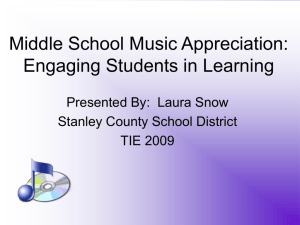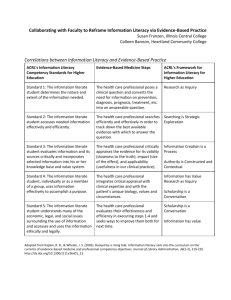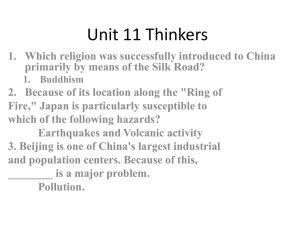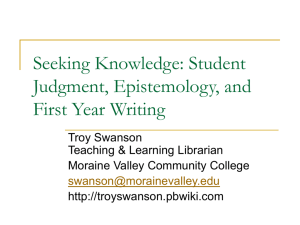Critical Thinking About Media - Media Literacy Clearinghouse
advertisement
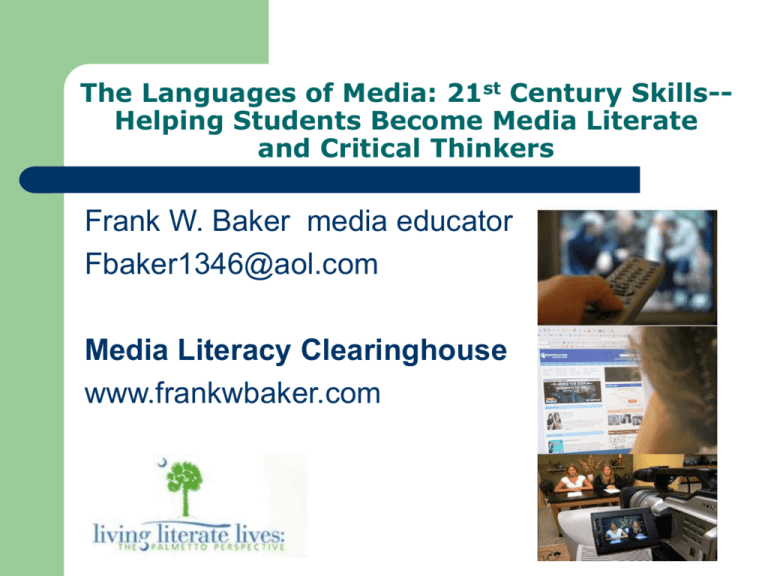
The Languages of Media: 21st Century Skills-Helping Students Become Media Literate and Critical Thinkers Frank W. Baker media educator Fbaker1346@aol.com Media Literacy Clearinghouse www.frankwbaker.com The Languages of Media: 21st Century Skills-Helping Students Become Media Literate and Critical Thinkers The Persuaders Dec. 19 ETV 10-11pm Copyright: ONE YEAR explores how the cultures of marketing and advertising have come to influence not only what Americans buy, but also how they view themselves and the world around them. www.pbs.org/frontline The Languages of Media: 21st Century Skills-Helping Students Become Media Literate and Critical Thinkers With the advent and popularity of YouTube, Current TV, and similar venues, young people are anxious to have their productions seen and heard. DIY (do it yourself) The Languages of Media: 21st Century Skills-Helping Students Become Media Literate and Critical Thinkers Generation M: Multi-tasking “digital natives” The Languages of Media: 21st Century Skills-Helping Students Become Media Literate and Critical Thinkers “Our students are growing up in a world saturated with media messages…yet, they (and their teachers) receive little or no training in the skills of analyzing or re-evaluating these messages, many of which make use of language, moving images, music, sound effects.” R.Hobbs, Journal Adult & Adolescent Literacy, February 2004 The Languages of Media: 21st Century Skills-Helping Students Become Media Literate and Critical Thinkers “Adolescents need to learn how to integrate knowledge from multiple sources, including music, video, online databases and other media. They need to think critically about information….they need to participate in the kinds of collaboration that new communication and information technologies enable, but increasingly demand.” Bruce Bertram, “Diversity and Critical Social Engagement: How Changing Technologies Enable New Modes of Literacy in Changing Circumstances” The Languages of Media: 21st Century Skills-Helping Students Become Media Literate and Critical Thinkers Literacy is more than words on a page. Text is not always printed. The Languages of Media: 21st Century Skills-Helping Students Become Media Literate and Critical Thinkers Media literacy refers to composing, comprehending, interpreting, analyzing, and appreciating the language and texts of...both print and nonprint. The use of media presupposes an expanded definition of 'text'...print media texts include books, magazines, and newspapers. Nonprint media include photography, recordings, radio, film, television, videotape, video games, computers, the performing arts, and virtual reality…constantly interact...(and) all (are) to be experienced, appreciated, and analyzed and created by students.“ (Source: ) Groups recognizing/recommending media literacy American Academy of Pediatrics American Association of School Librarians Annenberg Public Policy Center Cable In The Classroom Carnegie Commission on Adolescent Development Center for Substance Abuse Prevention College Board: Standards for College Success International Reading Association National Board for Professional Teaching Standards National Council for Teachers of English National Council for the Social Studies National Middle School Association National PTA North Central Regional Educational Laboratory (NcREL) Office of National Drug Control Policy Partnership for 21st Century Skills The Languages of Media: 21st Century Skills-Helping Students Become Media Literate and Critical Thinkers Revised SC ELA Standards (2007) Guiding Principle 8 An effective English language arts curriculum provides for literacy in all forms of media. The Languages of Media: 21st Century Skills-Helping Students Become Media Literate and Critical Thinkers “Movies, advertisements, and all other visual media are tools teachers need to use and media we must master if we are to maintain our credibility in the coming years.” Jim Burke, from The English Teacher’s Companion The Languages of Media: 21st Century Skills-Helping Students Become Media Literate and Critical Thinkers Take a moment to write your own definition of media literacy. The Languages of Media: 21st Century Skills-Helping Students Become Media Literate and Critical Thinkers Media literacy is the ability to: ACCESS ANALYZE INTERPRET and PRODUCE communication in a variety of forms. The Languages of Media: 21st Century Skills-Helping Students Become Media Literate and Critical Thinkers Media literacy is concerned with helping students develop an informed and critical understanding of the nature of mass media, the techniques used by them, and the impact of these techniques. More specifically, it is education that aims to increase the students' understanding and enjoyment of how the media work, how they produce meaning, how they are organized, and how they construct reality. Media literacy also aims to provide students with the ability to create media products. (Source: Ontario Ministry of Education) The Languages of Media: 21st Century Skills-Helping Students Become Media Literate and Critical Thinkers 5 Core Concepts in Media Literacy •All media are constructions •Media utilize unique languages with their own set of rules •Media convey values and points of view •Audiences negotiate meaning •Media are designed for power and profit All media are constructions media construct reality Media use their own languages The Language of IM The Language of Film BRB Be Right Back PIR Parents In Room LOL Laughing out Loud Cameras Lights Audio (sound, music) Editing Set Design Costume Actors’ expressions Makeup Cell phones ROAMING? (is this about deer and antelopes?) SMART PHONES? ( do dumb phones exist?) DROPPED CALLS ( dropping the phone?) Media: values and points-of-view Audience negotiate meaning Media= Power + Profit The Big (6) Media in the U.S. FOX (News Corp) NBC (GE/NBC/Universal) CBS ABC (Disney) CNN (AOL/Time Warner) VIACOM The Languages of Media: 21st Century Skills-Helping Students Become Media Literate and Critical Thinkers Learning to ask questions: Who created/paid for the message? What is the purpose? Who is the intended audience? What techniques are used? Who or what might be omitted and why? What lifestyles are promoted? Who benefits from the message? The Languages of Media: 21st Century Skills-Helping Students Become Media Literate and Critical Thinkers Photography (visual literacy) News & editorial cartoons (journalism) Advertising (techniques of persuasion) Film (the language of film) Video & media production The Languages of Media: 21st Century Skills-Helping Students Become Media Literate and Critical Thinkers The Languages of Media: 21st Century Skills-Helping Students Become Media Literate and Critical Thinkers The language of TV & Film CAMERAS 1. Movement 2. Position 3. Lens LIGHTS SOUND (includes music) EDITING (post production) SET DESIGN ACTORS (voice, expression, wardrobe) The Languages of Media: 21st Century Skills-Helping Students Become Media Literate and Critical Thinkers VISA Commercial Questions to consider (handout) Scriptwriting In The Classroom "If video is how we are communicating and persuading in this new century, why aren't more students writing screenplays as part of their schoolwork?" Heidi Hayes Jacobs The language of TV & Film Moving images: Television Cell Phone Ad Script Dove’s Campaign for Beauty campaign streaming video Bush Kerry Moving Images: Film To Kill A Mockingbird The Mighty (Freak The Mighty) Music Symbolism: Opening Titles Pocket Watch Sound in the Night POV Resources Most school libraries are sorely lacking in resources about media. Recommended books, magazines, videos, curricula and more can be found at www.frankwbaker.com/resources.htm Invite Frank to your school! Planning Staff Development? Media Literacy: One of the 21st Century Literacy Skills Frank Baker fbaker1346@aol.com



